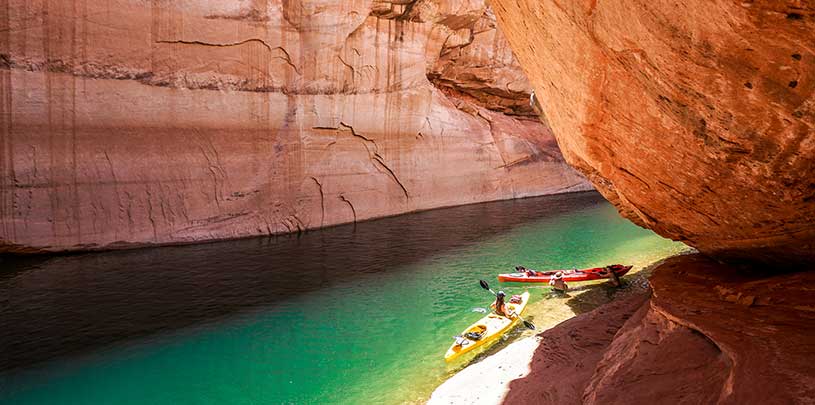
Guest post by Zak Podmore
On Lake Powell, human-caused climate change is not some future scenario outlined in computer models or long-term forecasts. The effects of global warming are already written on the very walls of Glen Canyon in the high white bathtub ring of bleached rock that marks how far the reservoir’s level has fallen since it was last full in 1999.
It’s well known that the Colorado River Basin, which is entering its 25th year of megadrought, is facing a crisis as the planet warms. Reduced snowpack is threatening the water supply of the 40 million people who rely on the river, and Lake Powell — the second-largest reservoir in the United States after Lake Mead — is at the center of the crisis.
But beneath the bathtub ring, along the dozens of perennial tributary streams that flow into Glen Canyon, something surprising is underway. Fifty-foot-tall cottonwood trees are growing along the edges of willow-lined beaver ponds. Patches of native wildflowers are flourishing where bass fishermen once dropped their lines from aluminum boats. Cultural sites that were flooded after Lake Powell began to fill behind the Glen Canyon Dam in 1963 have resurfaced along with countless places sacred to the Diné, Hopi, Zuni, San Juan Southern Paiute, Kaibab Paiute, Ute, and other tribes with ancestral ties to the area. The Colorado and San Juan rivers are scouring out reservoir muck from canyon bottoms where whitewater rapids are returning.
 Lake Powell, January 2023. AMY S. MARTIN
Lake Powell, January 2023. AMY S. MARTIN
In short, Glen Canyon — the loss of which was seen as one of the great environmental tragedies of the 20th century — is undergoing a remarkable rebirth, not in spite of 21st century climate change but because of it.
In 2021, I joined a group of scientists organized by the Moab-based Returning Rapids Project on a week-long trip to Lake Powell, where I witnessed this transformation firsthand. I’d grown up rafting Utah rivers, and I’d spent a decade reporting on water issues in the Southwest as a journalist. Most environmental reporting contains its share of grim statistics, and I’d never expected houseboat-studded Lake Powell would provide such a stunning counterexample. What I witnessed that week defied my assumption that the area was a kind of sacrifice zone to water development. In the side canyons, rewilding was not an abstract concept; it was manifest in every native plant that had reestablished.
I spent the next two years returning to Lake Powell with archaeologists, ecologists, economists, water policy experts, Indigenous activists, geologists, and environmentalists. We hiked together in the majority of Glen Canyon’s tributaries, kayaked around bizarre mud islands of fractured reservoir sediment, and talked about the varied aspects of the canyon’s transformation.
The reservoir fell to record-low levels in 2022 and 2023, declining to around a quarter of its capacity and threatening to drop Lake Powell’s level to the lowest outlets on the Glen Canyon Dam: a point known as “dead pool.” Last year’s above-average runoff helped some, but hydrologists warn that dead pool could still arrive with just a couple more bad snow years.
At dead pool, billions of gallons of water would be essentially trapped in the reservoir with no way to release them. The Grand Canyon would see its lowest flows in decades, threatening humpback chub populations and other endangered species recovery programs as well as the canyon’s world-famous river recreation.
Water managers have indicated that dead pool must be avoided at all costs. Reducing water demand is one necessary part of the response, and the U.S. Bureau of Reclamation, which manages the dam, is studying its options, including the possibility of modifying the dam, demonstrating just how serious the climate crisis in the Colorado River Basin has become. Whatever the course of action, tribal nations, which have long been excluded from land and water negotiations, must be at the table, and could — and should — be invited to comanage Glen Canyon National Recreation Area.
Since the higher reaches of Lake Powell have been exposed continuously for over 20 years, the low reservoir levels present an opportunity to study ecological recovery on a large scale, and multiple scientists I interviewed referred to the former bed of Lake Powell as a “living laboratory.”
Biologists conducting basic plant surveys in the side canyons have already been impressed by the diversity of native species that have returned. Geologists are documenting how sediment is moving through Glen Canyon’s upper reaches, and soil scientists see the potential to study the growth of biocrusts in a disturbed landscape. Other researchers are using remote satellite imagery to track ecological changes.
We already have proof that the canyons once flooded by Lake Powell are healing of their own accord. With more funding for scientific research and management policies that incorporate Indigenous knowledge as well as the reality of climate change, those emerging ecological and cultural values could be protected. Perhaps it's time we embrace our drier future and start thinking of Glen Canyon not just as a national recreation area, but as a national restoration area.
Zak Podmore is a writer based in southern Utah. He’s the author of the forthcoming book Life After Dead Pool: Lake Powell’s Last Days and the Rebirth of the Colorado River.
Guest writers’ opinions are solely their own and do not represent the views of the Grand Canyon Trust.
The Colorado River below Glen Canyon Dam is heating up. Find out why.
Read MoreGroundwater pumping at a uranium mine near the Grand Canyon will affect the canyon's springs, scientists says.
Read MoreHow does Colorado River water get divvied out to Colorado, Utah, Arizona, New Mexico, Nevada, California, Wyoming, Native American tribes, and Mexico?
Read More